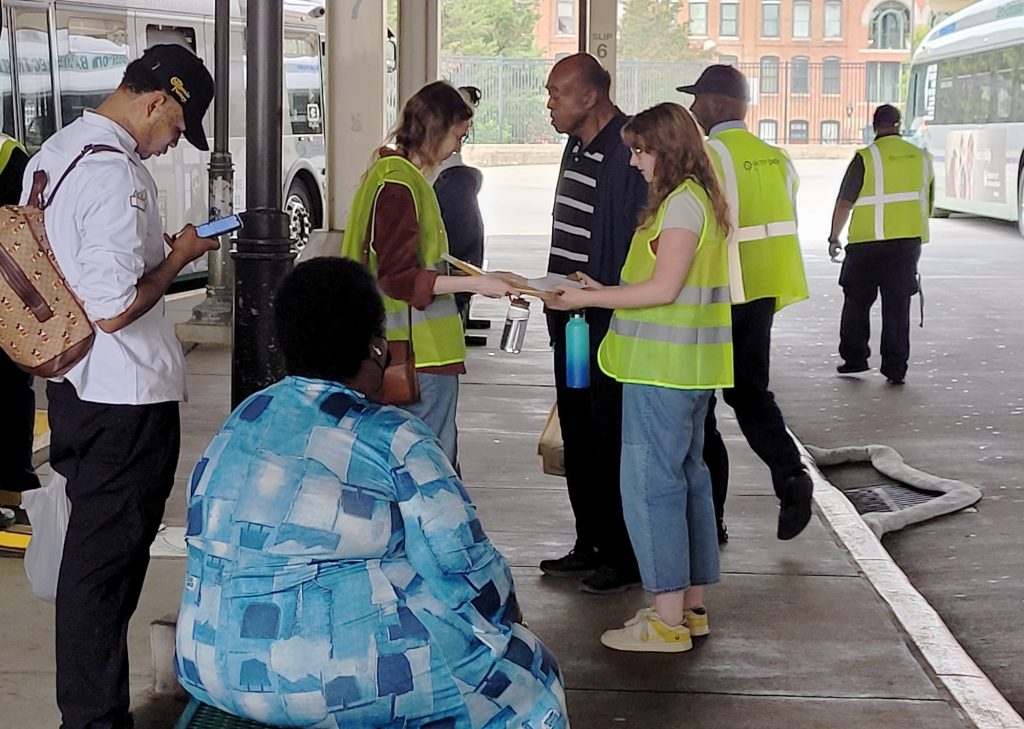Considering a Car-Optional Greensboro
By Hanna Cockburn and Reginald Mason | 8/13/2024
BY HANNA COCKBURN, AICP
Director of Transportation
And REGINALD MASON
Transit Department Director
Greensboro, NC

What would Greensboro, North Carolina, look like if it were car-optional in 2045? That question, and the projected impact of its answers, are baked into the “GoBoro 2045 Transit Plan,” a collaborative planning effort that includes the City of Greensboro, the Greensboro Transit Agency (GTA), regional partners, transit stakeholders, and members of the community who all are coming together to decide on the vision and goals for Greensboro’s investment in public transit.
According to the American Automobile Association, it costs nearly $10,000 per year to own and operate a vehicle. It’s a safe bet that the costs associated with automobile ownership will not diminish over time. So, as we seek to help residents in our city—especially those who only own one vehicle or are solely dependent on public transportation to get to and from their homes or jobs—what can we as a municipal transportation department and transit agency do to enhance the quality of life through a car-optional approach?
As we have considered this question, we’ve also wondered aloud about the potential impacts that our residents would experience if they were to give up dependence upon cars as their primary mode of transportation. And, of course, it leads us to believe that if car-optional transportation is the goal, bus transit must become much more useful for Greensboro residents, workers, and visitors. That will take more investment in transit to expand bus service in more areas and make it easier to use.
Over the last two years, we’ve partnered with the transit-planning team at Jarrett Walker + Associates to explore the long-term future of the transit network in Greensboro and help us gauge the needs and prospective interests of our ridership and residents. It has been important to educate our residents on what “car-optional” could mean for Greensboro and to present choices that the community can consider as we envision transit services that get us closer to fulfilling this goal. These choices are important because they result in very different transit networks with very different outcomes for the people, businesses, and institutions of Greensboro.

Based on initial stages of public engagement conducted in 2023, and through the guidance of Jarret Walker + Associates, we have rolled out a draft network that includes feedback from stakeholders and community members regarding ridership/coverage balance and the needed investment to make transit more appealing to riders.
With that feedback incorporated, we’re now exploring what a transit network would look like that includes 70 percent of the resources focused on improved frequency and 30 percent focused on expanding coverage. To make that concept a reality, the Greensboro City Council has recommended a study to be completed in coordination with other transit partners across the Triad to explore a county sales tax referendum. When surveyed, 80 percent of respondents indicated they would be likely to support such an effort if it improved ridership options.
Among the options to enhance ridership in the draft plan is the movement away from a traditional hub and spoke system, and the creation of more frequent cross-town routes that run through the downtown area, and other major job and retail zones. These routes run at 15-minute intervals instead of the standard 30 minutes and provide more opportunities for riders to access jobs, retail, universities, hospitals, and other important destinations.

While the draft network focuses more resources on ridership goals, concentrating service into frequent routes in the densest and busiest areas, the tradeoff is that with significant increases in funding, we envision that transit can be offered in new areas away from the core of Greensboro and not served by transit today. To show a proof of that concept, we launched a new cross-town route in March. After five weeks of service, the new route was generating north of 10,000 riders per week, nearly 3,500 more than the traditional routes that the cross-town option replaced.
By comparing the existing network to the draft network, the benefits to multiple resident groups and their ability to access jobs more than doubles. Withing the existing network, the typical Greensboro resident can reach 6,500 jobs within 45 minutes. The draft network drastically increases people’s access to jobs. In fact, a typical Greensboro resident could reach roughly twice as many jobs in the draft network—around 6,500 more jobs. If we consider access changes for various groups of people, we see large changes in job access in the draft network:
- For residents in poverty, job access increases by 118 percent, which is 15,200 more jobs.
- For households without cars, job access increases by 87 percent, or 18,700 jobs.
- For residents of color, job access increases by 147 percent, or 12,500 jobs.
- For young residents, job access increases by 97 percent, or 6,100 jobs.
- For seniors, job access increases by 90 percent, or 4,700 jobs.
All totaled, the draft network would provide “15 minute” routes to more than 70,000 jobs in the Greensboro community.
While our vision of a car-optional community is coming together, the idea that the quality of life for all of Greensboro’s residents can be preserved, or enhanced, has been an overwhelming theme. As we work this summer to put the finishing touches on a recommended plan, we look forward to working with our community and leadership to continue to explore ways to make public transportation easy, efficient, equitable, reliable—and most importantly—a vital service to our residents for decades to come.